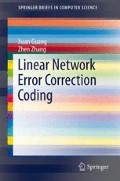Abstract
In this chapter, we introduce another equivalent description of linear network error correction (LNEC) model so as to facilitate important and interesting problems in linear network error correction coding such as encoding, decoding, analysis and constructions of LNEC codes, etc. Actually, this description is a local approach to represent linear network error correction coding process, which can be used to restate LNEC codes. Like linear network codes, we also introduce local encoding kernels and extended global encoding kernels for LNEC codes, which respectively correspond to a so-called local description and a so-called global description of LNEC codes. And thus, we can redefine the distance and the weight for a LNEC code, which simplify their construction and decoding.
Access this chapter
Tax calculation will be finalised at checkout
Purchases are for personal use only
Notes
- 1.
In order to facilitate our discussion, we assume that all imaginary message channels and imaginary error channels have no tail nodes. Actually, we can take for granted that there is an auxiliary node s′ as the tail node for all imaginary message channels, i.e., s′ generates all source messages, and similarly, there is another auxiliary node s ∗ as the tail node for all imaginary error channels, i.e., s ∗ generates all error messages. Particularly, s′ and s ∗ are allowed to be the same one.
References
H. Balli, X. Yan, and Z. Zhang, “On randomized linear network codes and their error correction capabilities,” IEEE Trans. Info. Theory, IT-55: 3148–3160, 2009.
X. Guang, F.-W. Fu, and Z. Zhang, “Construction of Network Error Correction Codes in Packet Networks”, NetCod 2011, Beijing, China, July 25–27, 2011.
X. Guang, F.-W. Fu, and Z. Zhang, “Construction of Network Error Correction Codes in Packet Networks,” IEEE Trans. Info. Theory, IT-59: 1030–1047, 2013.
X. Yan, H. Balli, and Z. Zhang, “Decode Network Error Correction Codes beyond Error Correction Capability,” preprint.
Z. Zhang, “Network error correction coding in packetized networks,” 2006 IEEE Information Theory Workshop, Chengdu, China, 2006.
Z. Zhang, “Linear network error correction codes in packet networks,” IEEE Trans. Info. Theory, IT-54: 209–218, 2008.
Z. Zhang, “Some recent progresses in network error correction coding theory,” NetCod 2008, Hong Kong, China, Jan. 2008.
Z. Zhang, “Theory and Applications of Network Error Correction Coding,” Proceedings of the IEEE, 99: 406–420, March 2011.
Z. Zhang, X. Yan, and H. Balli, “Some key problems in network error correction coding theory,” 2007 IEEE Information Theory Workshop, Bergen, Norway, Jul. 2007.
Author information
Authors and Affiliations
Rights and permissions
Copyright information
© 2014 The Author(s)
About this chapter
Cite this chapter
Guang, X., Zhang, Z. (2014). Another Description of Linear Network Error Correction Model. In: Linear Network Error Correction Coding. SpringerBriefs in Computer Science. Springer, New York, NY. https://doi.org/10.1007/978-1-4939-0588-1_3
Download citation
DOI: https://doi.org/10.1007/978-1-4939-0588-1_3
Published:
Publisher Name: Springer, New York, NY
Print ISBN: 978-1-4939-0587-4
Online ISBN: 978-1-4939-0588-1
eBook Packages: Computer ScienceComputer Science (R0)

